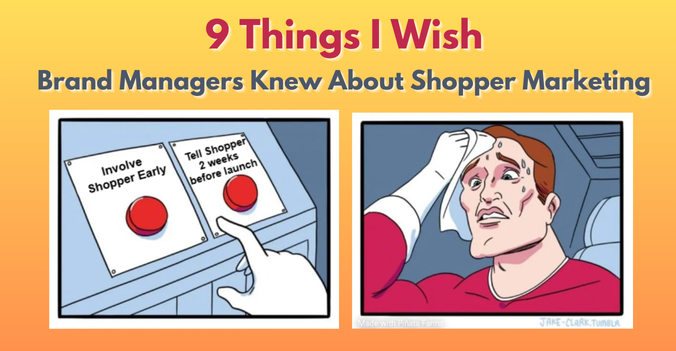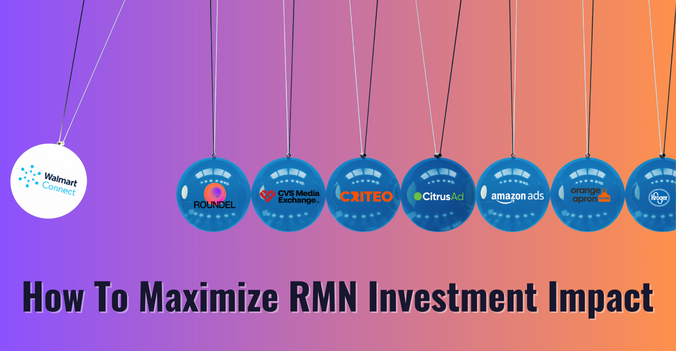
Most CPG marketers are facing pressure to invest more and more into retail media each year. This pressure is not about to lessen any time soon.
According to EMARKETER forecast, total US omnichannel retail media spend will total almost $60Bn this year and will exceed $100Bn by the end of 2027.
Retail media is becoming a major, if not the main, type of omnichannel marketing investment for many CPG companies. Due to its large size and aggressive growth, RMN investment is becoming an important strategic lever in the retailer-manufacturer relationships and now plays a significant role in the customer Joint Business Planning (JBP) process, on par with trade spend.
RMN Challenges
Ability to use RMN investments strategically is what sets winning CPGs apart from the rest. However, a typical CPG enterprise may struggle with building cohesive and consistent RMN strategy for several reasons:
- Retail media definition is a moving target and varies from retailer to retailer. The taxonomy, the ad product offerings, the scope of RMN is still evolving. Some retailers are starting to digitize their physical stores and offer their in-store media under the RMN umbrella. It will be a while before industry standards are established and the retail media landscape matures. In the meantime, shopper marketers have to constantly test, learn and quickly adapt to the changing RMN landscape while also educating their internal organizations.
- RMN activation may be outsourced. RMN is often outsourced to external media agencies due to their media buying expertise. As a media investment, RMN spend could then be aggregated with traditional brand media spend. For example, agencies may be using retailer offsite media and running pure brand creative (versus shopper marketing messaging that aims to drive a purchase). In such cases, this investment may not be recognized and credited toward annual retailer RMN commitment. Another issue is that brand media buys are often made much later in the planning cycle than shopper marketing buys, thus missing key milestones for the customer’s planning timeline. As a result, RMN investment may not get planned early enough to affect retailers’ merchandising plans and may not get discussed with retailers as part of JBP conversations.
- Total RMN investment is hard to assess due to silos. Retail media scope has grown in scope to a point where specialized departments or media agencies are put in charge of various parts of RMN planning. A typical scenario: sponsored search campaigns are planned by the e-commerce team, in-store tactics are planned by the shopper marketing team, digital coupons are deployed by the Associate Brand Manager, and on-planform digital ads are outsourced to the agency. These silos result not only in poor coordination, conflicting messaging and deeper than necessary discounting, they also make it nearly impossible to total up and communicate the RMN spend to sales teams and retail customers.
These challenges are not trivial and affect many CPG organizations, as evident from the recent Shopperations’ poll on the topic. More than 60% of CPG respondents admit to not leveraging RMN investment with their retailers consistently.
Best Practices For Strategic RMN Planning
When planning your RMN investments, consider the following best practices to help drive the optimal total return for your brands and your entire CPG enterprise.
1. Think Beyond Display & Search
As a shopper marketer, your brands’ RMN spending is a key part of your dialog with retailer marketing and merchandising teams. During your annual strategic budgeting process, it is important to think holistically about these investments, as there are many components to retailer media, some which are not even planned by you and your team.
Recently, paid search along with on-site and off-site display advertising have captured the majority of attention of shopper marketers and have been the focus of many industry conversations. But there is a sizable group of tactics that CPGs execute that live in an amorphous category of “Other Retail Media”, which are often overlooked.
These can be digital or traditional shopper marketing tactics, such as email, direct mail, shelf and store signage, in-store audio, and even demos. Don’t lose sight of these investments. They should all count in the grand total of what you are bringing to the retailer in the way of annual support.
2. Maximize your RMN Credit
For these “Other Retail Media” tactics to qualify as retail media, they should meet one or more of the following criteria:
- They are executed in retailers’ physical stores, or via their digital platforms (for instance, digital load to card coupons executed via retailer.com site).
- They target retailers’ shoppers using shoppers’ purchase data (for example, direct mail to retailer’s loyal shoppers with personalized offers)
- The retailer has direct influence on which exclusive vendor partners are allowed to execute these tactics on behalf of retailer (for instance, some retailers have preferred demo vendor companies that are allowed to run in-store sampling activities)
- These activities are revenue-generating for retailers, either via revenue share from vendors or direct billing to CPG brands via deductions (such as sponsorship fees or scale program participation fees, for example)
Make sure to vet these assumptions with your retail partners since not all of them are on the same page in terms of what counts as “Other Retail Media”. There may be gray areas, too, for example, third party vendor tactics executed in or near the retailer’s stores, but not formally affiliated with the retailer may or may not get RMN credit.
3. Break Down Silos To Plan Holistically
As you align with your retail partners and internal stakeholders on the definition of Retail Media, ensure that Retail Media planning is part of Integrated Marketing Planning for your organization. This is particularly important if Retail Media scope is fragmented and owned by multiple teams inside your company. Group RMN investments into three major categories:
- RMN Search
- RMN Display
- RMN Other
The important thing here is that you are now capturing all marketing investments directly with the retailer and can reference a higher level of spending when you are in planning discussions with your retailer marketing and merchandising partners. If your team and budgets are organized so that RMN Search and Display are owned by one team and RMN Other by a different group, have an easy way to aggregate your investments for presentation and negotiation purposes.
4. Plan Early Enough To Inform JBP Discussions
To maximize RMN impact on your bottom line, be ready to present your fiscal year investment to retailers during the annual Joint Business Planning meetings and other top-to-top discussions. These meetings happen very early, typically months in advance of in-market dates.
These long lead times will likely affect your internal annual operating planning schedule and will require early pre-alignment with Brands and Sales. The outcome of these pre-alignment calls is not to set your final plan(s), but rather to have an internally approved total investment for retailers to react to and help you shape your RMN strategy.
5. Align On And Present Your Asks
Since RMN investment is not optional, be proactive and strategic when you respond to increasing demands from retailers. You should always have an ask or two for the retailer for the upcoming fiscal year’s RMN investment.
It is critical to have alignment within your enterprise team across Sales, Sales Planning/Customer Development and Brand Marketing on what you are asking the retailer for in return to help drive their categories and your brands. Your objective may be to increase base distribution, win quality merchandising during priority weeks or secure new item acceptances—OR a combination of all three.
IMPORTANT: get all the “asks” on the table while the RMN investment is under discussion. Once you agree on an annual investment, it may be significantly more difficult to go back to the retailer with an ad hoc request. Know your priorities in advance.
In situations where planning with your retailers is more fluid and evolves throughout the year, you may be in position to take a different approach. Within this scenario, it may be more beneficial to present the RMN investment on a program by program basis. This allows your team and organization to stay focused on specific objectives while giving you the flexibility to adapt to changing business conditions. By making smaller, individual commitments on a rolling schedule, you have the ability to redeploy RMN funds to needs that may not have been visible at the much earlier date when an annual commitment was required.
6. Track Execution Against Retailer Commitments
Document the agreements coming out of your JBP meetings and carefully monitor both your RMN execution for each account as well as Retailers’ support that was promised in return. Regularly update your original forecast and actualize RMN spend across all the teams involved in RMN execution to be able to quickly react to changing market conditions or to follow up with retailers and keep them updated on your latest plans.
To simplify and streamline RMN planning and actualization, consider investing in an omnichannel planning software like Shopperations. A good planning solution will streamline the RMN taxonomy across departments, capture all the important details about marketing campaigns (in-market dates, promoted products, vendors, tactics, creative artwork, KPIs, actual billing, etc.), will be easy to use for marketers and will answer any questions from your internal stakeholders as well as external customers without distracting your team.
Do you struggle with capturing your RMN investments and thus can’t fully leverage them with your retail customers? Reach out to Shopperations for a free consultation & software demo.
Other Posts You May Like:
AGENCY VS. CLIENT: DECIDING THE SHOPPER MARKETING CAREER PATH
6 REASONS WHY SHOPPER MARKETING JOB IS SO TOUGH
7 PEOPLE EVERY SHOPPER MARKETING TEAM NEEDS









